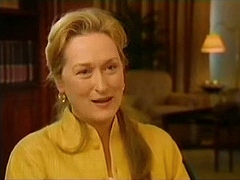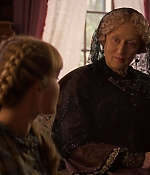|
Simply Streep is your premiere online resource on Meryl Streep's work on film, television and in the theatre - a career that has won her acclaim to be one of the world's greatest living actresses. Created in 1999, Simply Streep has built an extensive collection over the past 25 years to discover Miss Streep's body of work through thousands of photographs, articles and video clips. Enjoy your stay and check back soon.
|
Here we are, 24 days into our calendar. I wish all visitors Happy Holidays and all the best, much health and best of luck for the next year. We’re wrapping our site special with a massive update of Blu-Ray screencaptures of Meryl’s leading roles in feature films, “Marvin’s Room”, Music of the Heart”, “Doubt” and “Julie & Julia”. Enjoy the updates and see you all next year.
Photo Gallery – Career Photography – Julie & Julia – Blu-Ray Screencaptures
Photo Gallery – Career Photography – Doubt – Blu-Ray Screencaptures
Photo Gallery – Career Photography – Music of the Heart – Blu-Ray Screencaptures
Photo Gallery – Career Photography – Marvin’s Room – Blu-Ray Screencaptures
As we’re heading close to our finale, the final batch of additional puplic appearances pictures have been added. These are ranging from as early as 1978 throughout the 1980s with several press junkets and award show appearances to 1990, when Meryl was not only busy promoting “Postcards from the Edge”, but also making the rounds raising awareness for environmental issues. Check back tomorrow for the last entry in our calendar with a very big, last update.
Photo Gallery – Public Appearances – 1990 – Postcards from the Edge Premiere
Photo Gallery – Public Appearances – 1990 – Warner Bros. Studio Rededication
Photo Gallery – Public Appearances – 1989 – MacDowellBenefit at Christies
Photo Gallery – Public Appearances – 1989 – 46th Annual Golden Globe Awards
Photo Gallery – Public Appearances – 1989 – New York Film Critics Circle Awards
Photo Gallery – Public Appearances – 1984 – Helen Caldicott Leadership Awards
Photo Gallery – Public Appearances – 1983 – Silkwood Press Junket Beverly Hills
Photo Gallery – Public Appearances – 1983 – National Theater Owners Awards
Photo Gallery – Public Appearances – 1983 – 8th Annual Cesar Awards
Photo Gallery – Public Appearances – 1980 – Oscar Nominees’ Party at Tavern Green
Photo Gallery – Public Appearances – 1980 – Kramer vs. Kramer Photocall London
Photo Gallery – Public Appearances – 1978 – Los Angeles Restaurant Sighting
In our second-to-last public appearances update, updates range from 2017 to 2019 and feature two promo-heavy years with appearances for “Florence Foster Jenkins” and the releases of “The Post” and “Big Little Lies.”
Photo Gallery – Public Appearances – 2019 – “Big Little Lies” Vanity Fair Conversation Panel
Photo Gallery – Public Appearances – 2018 – 90th Annual Academy Awards – Show
Photo Gallery – Public Appearances – 2018 – National Board of Review Awards
Photo Gallery – Public Appearances – 2018 – 75th Annual Golden Globe Awards – Show
Photo Gallery – Public Appearances – 2017 – Kennedy Center Honors – Show
Photo Gallery – Public Appearances – 2017 – 31st Annual Citymeals on Wheels Power Lunch for Women
Photo Gallery – Public Appearances – 2017 – CPJ International Press Freedom Awards
Photo Gallery – Public Appearances – 2017 – 89th Annual Academy Awards – Show
Photo Gallery – Public Appearances – 2017 – 89th Annual Academy Awards – Arrivals
Photo Gallery – Public Appearances – 2017 – 19th Annual Costume Designers Guild Awards
Today’s calendar brings a big update of various television specials and appearances, both as videos and as screencaptures. Starting with videos, additions include talkshow appearances on “The Early Show” and “The Today Show” to promote “The Iron Lady”, wonderful vintage tv reports on “Sophie’s Choice”, including interviews with Meryl, as well as her appearance at the 2017 Kennedy Center Honors. There’s also an appearance on the 2002 BBC1 documentary “There’s Only One Paul McCartney”.
Moving on to the screencaptures, most of the above appearances have been capped. Various appearances, such as “The Ellen DeGeneres Show”, the 2002 documentary “New York at the Movies”, a 2013 documentary on Clint Eastwood and two press junkets for “Marvin’s Room” have been replaced with better quality captures. A full list of updates can be found below.
Video Archive – Award Shows – Society Of Camera Operators Awards (2018)
Video Archive – Public Appearances – Into the Woods New York Q&A (2014)
Video Archive – Talkshows – The Today Show (2011)
Video Archive – Television Specials – There’s Only One Paul McCartney
Video Archive – Talkshows – The Early Show (2011)
Video Archive – News Segments – WKY News (1983)
Photo Gallery – Public Appearances – 2017 – Kennedy Center Honors – Screencaptures
Photo Gallery – TV & Online Appearances – Eastwood: The Untold Story (2013)
Photo Gallery – TV & Online Appearances – The Today Show (January 16, 2012)
Photo Gallery – TV & Online Appearances – The Ellen DeGeneres Show (2012)
Photo Gallery – TV & Online Appearances – The Early Show (December 27, 2011)
Photo Gallery – TV & Online Appearances – The Ellen DeGeneres Show (2005)
Photo Gallery – TV & Online Appearances – There’s Only One Paul McCartney (2002)
Photo Gallery – TV & Online Appearances – New York at the Movies (2002)
Photo Gallery – Public Appearances – Bette Davis Lifetime Achievement Award – Screencaptures
Photo Gallery – TV & Online Appearances – “Marvin’s Room” Press Junket (1997)
Photo Gallery – TV & Online Appearances – “Marvin’s Room” Press Junket (1996)
Photo Gallery – Public Appearances – 32nd Annual Grammy Awards – Screencaptures
A second batch of magazine scans have been added with today’s calendar. There are some great cover stories from around the world and articles from Spain, Poland, the United Kingdom, Austria, and many more. Many thanks to Alvaro for sending in most of these. Very appreciated. Enjoy reading.
Photo Gallery – Articles & Scans – Saga Magazine (United Kingdom, September 2024)
Photo Gallery – Articles & Scans – Vivir Oviedo (Spain, October 2023)
Photo Gallery – Articles & Scans – Viva (Argentina, September 10, 2023)
Photo Gallery – Articles & Scans – TV Max (Poland, November 25, 2022)
Photo Gallery – Articles & Scans – Nök Lapja (Hungary, January 06, 2021)
Photo Gallery – Articles & Scans – Moments (Austria, March 2018)
Photo Gallery – Articles & Scans – Acqua & Sapone (Italy, January 2017) (replaced)
Photo Gallery – Articles & Scans – Metro Life (replaced)
Photo Gallery – Articles & Scans – Noticias Magazine (Portugal, January 08, 1995)
Photo Gallery – Articles & Scans – The Sunday Times Magazine (United Kingdom, December 11, 1994)
More Blu-Ray screencaptures have been added, this time with a focus on the mid-2000s, in which Meryl was seen in “The Manchurian Candidate”, “Lemony Snicket’s A Series of Unfortunate Events” and “Lions for Lams”. Screencaptures for “Little Women” have been updated as well.
Photo Gallery – Career Photography – Little Women – Blu-Ray Screencaptures
Photo Gallery – Career Photography – Lions for Lambs – Blu-Ray Screencaptures
Photo Gallery – Career Photography – Lemony Snicket – Blu-Ray Screencaptures
Photo Gallery – Career Photography – The Manchurian Candidate – Blu-Ray Screencaptures
We’re still not done with public appearances – there have been many great finds to add to the site. Today’s update includes Meryl’s most recent events at this year’s Grammy Awards and Screen Actors Guild Awards as well as Rufus Wainright’s “Dream Requiem” performance in Paris.
Photo Gallery – Public Appearances – 2024 – Rufus Wainwright: Dream Requiem – Show
Photo Gallery – Public Appearances – 2024 – 11th iHeartRadio Music Awards – Show
Photo Gallery – Public Appearances – 2024 – 30th Screen Actors Guild Awards – Show
Photo Gallery – Public Appearances – 2024 – “Sophie’s Choice” 40th Anniversary Screening at MoMA
Photo Gallery – Public Appearances – 2024 – Grammy Awards – Show
Photo Gallery – Public Appearances – 2023 – Hunter College Fete for Universal Human Rights
Photo Gallery – Public Appearances – 2021 – “Slave Play” Broadway Re-Opening Night
Photo Gallery – Public Appearances – 2020 – 26th Annual Screen Actors Guild Awards – Show
Photo Gallery – Public Appearances – 2019 – 44th Toronto International Film Festival – Variety Studio
With even more public appearances to update, today’s photos range from 2011 to 2014, featuring addtions from the exhausting awards campaign for 2011’s “The Iron Lady” as well as a couple of fundraisers and conversation panels.
Photo Gallery – Public Appearances – 2014 – Indiana University – IU Cinema Panel
Photo Gallery – Public Appearances – 2014 – Taping of “Ellen”
Photo Gallery – Public Appearances – 2013 – Taping of “The View”
Photo Gallery – Public Appearances – 2013 – Fundraiser for The Wilmington Fund VT
Photo Gallery – Public Appearances – 2013 – Foundation for Contemporary Arts Anniversary Gala
Photo Gallery – Public Appearances – 2012 – 18th Annual Screen Actors Guild Awards – Show
Photo Gallery – Public Appearances – 2012 – 17th Annual Critics Choice Movie Awards
Photo Gallery – Public Appearances – 2012 – 77th New York Film Critics Circle Awards
Photo Gallery – Public Appearances – 2012 – Taping of “50 Inside”
Photo Gallery – Public Appearances – 2011 – A Magical Evening Gala
The second batch of Blu-Ray screencaptures includes updates for “Manhattan”, “Kramer vs. Kramer” and “A Cry in the Dark”. Screencaptures in better quality have also been added from “Alice at the Palace”, the ABC television special from 1981 which remains an odd pleasure in Meryl’s career.
Photo Gallery – Career Photography – A Cry in the Dark – Blu-Ray Screencaptures
Photo Gallery – Career Photography – Alice at the Palace – Blu-Ray Screencaptures
Photo Gallery – Career Photography – Kramer vs. Kramer – Blu-Ray Screencaptures
Photo Gallery – Career Photography – Manhattan – Blu-Ray Screencaptures
In today’s calendar update, we continue with public appearances and new events ranging from 2006 to 2008. Updates include the Venice Film Festival premiere of “The Devil Wears Prada”, a visit to the Belfast Museum Arts Center in 2007 and a screening for the little-seen “Dark Matter” in 2008.
Photo Gallery – Public Appearances – 2008 – Creativity Foundation Laureat Prize
Photo Gallery – Public Appearances – 2007 – “Dark Matter” Screening New York
Photo Gallery – Public Appearances – 2007 – A Magical Evening Gala Benefit
Photo Gallery – Public Appearances – 2007 – Belfast Museum Arts Center – Gala Dinner
Photo Gallery – Public Appearances – 2007 – Belfast Museum Arts Center – Conversation Panel
Photo Gallery – Public Appearances – 2006 – Sherry Lansing Leadership Award
Photo Gallery – Public Appearances – 2006 – 20th Annual Power Lunch For Women
Photo Gallery – Public Appearances – 2006 – 63rd Venice Film Festival – Premiere
Photo Gallery – Public Appearances – 2006 – A Prairie Home Companion Independence Day Special
Photo Gallery – Public Appearances – 2006 – The Public Theater’s Summer Gala





















































